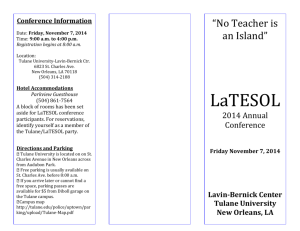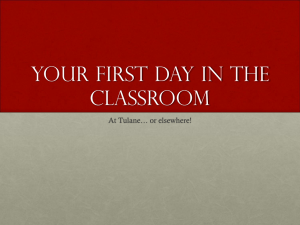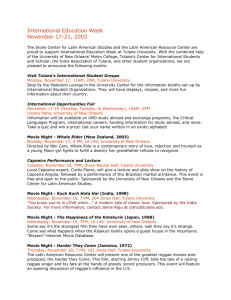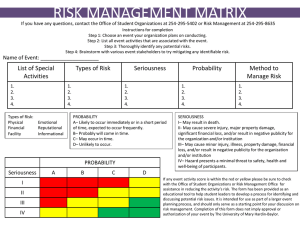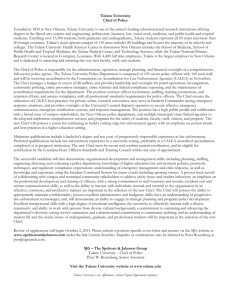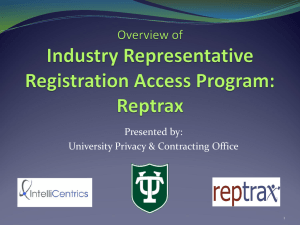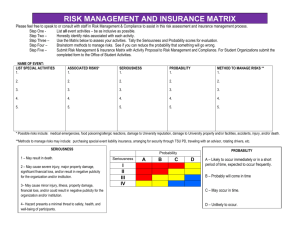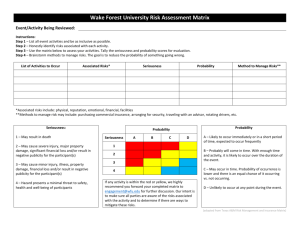Community Service Training Module
advertisement
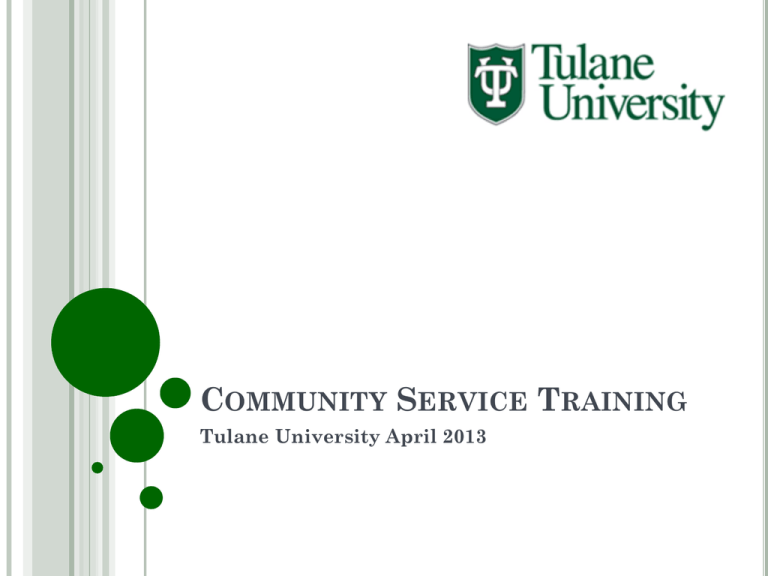
COMMUNITY SERVICE TRAINING Tulane University April 2013 COMMUNITY SERVICE ORGANIZATIONS TRAINING OVERVIEW Finding the right community partner Setting up your service experience Reducing risk Personal safety guidelines Preparing for your service experience On-site etiquette Tips for successful service experience WHAT CAN COMMUNITY SERVICE DO FOR YOU ORGANIZATION? Increase students’ awareness of their relationship with ever-widening circles of society Promote student leadership through project development Advance diversity awareness Promote networking and collaboration among student organizations and community agencies Provide easy fellowship/social programs for your organization FINDING THE RIGHT COMMUNITY PARTNER Talk to your members and advisor about their particular interests in community service: Where do we want to be? Do we want to serve as individuals or as a group? With what populations of people do we want to work with? How frequently to we want to serve? When will the community activities be held? What kind of work do we want to do? FINDING THE RIGHT COMMUNITY PARTNER If you do not already have a community agency in mind, here are a few resources: CPS Information System (on-going projects) Other student organizations (CACTUS, SAFER, HATT, etc.) Weekly updates from the TU Serves! mailing list. (short-term or date specific projects) www.idealist.org (long term, short-term or date specific projects) SETTING UP YOUR SERVICE EXPERIENCE When you contact the volunteer coordinator at your community partner site, let them know: Your interests One time or on-going placement Your organization’s availability Number of students participating Try to give as accurate numbers as possible. Special skills your group can offer computer, construction, painting, cooking etc. SETTING UP YOUR SERVICE EXPERIENCE Questions you should ask the volunteer coordinator: Special supplies needed your organization will be expected to supply? Safety guidelines? Safety equipment needed? (e.g. goggles, gloves, work boots, etc.) Required forms? Are background checks required? Special policies? (i.e. dress codes, lifting requirements, non-handicapped accessible facilities, etc.) Lunch, snacks, or water provided? Site supervision? REDUCING RISK Student leaders should research: The area in which you will be serving Be realistic about the area you are working in and the level of safety. Check the city’s crime map Ask the site staff about safety precautions. University policies and procedures The activity you will be working on Manual labor projects Projects with children Canvassing projects REDUCING RISK: SITE VISIT Student leaders can request a site visit prior to their service date. During this site visit, students leaders can observe: Working conditions Facilities Clientele Staff Access Site Safety REDUCING RISK: PLANNING Meet with your advisor and complete all paper work at least 2 weeks in advance Complete a risk assessment to determine the level of risk involved in your activity. Create a risk management plan at least two weeks before your event and train your leadership team and volunteers Partner with CPS suggested community agencies Provide university transportation for your volunteers Document and evaluate communications, planning process, finished project, participant feedback, and resources REDUCING RISK: RISK ASSESSMENT Students should consider the Seriousness of Risk I- May result in death or jail time II- May cause severe injury, major property damage, significant financial loss, and/or result in negative publicity for the organization, institution, or agency. III- May cause minor injury, illness, property damage, financial loss and/or could result in negative publicity for the organization and/or institution IV- May cause a minimal threat to safety, health and wellbeing of participants REDUCING RISK: RISK ASSESSMENT Students should consider the Probability that something will go wrong: A- Likely to occur immediately or in a short period of time, expected to occur frequently B- Probably will occur C- May occur D- Unlikely to occur REDUCING RISK: RISK ASSESSMENT After determining the probability and the seriousness of risk, determine the risk “score” of your activity. PROBABILITY SERIOUSNESS A B C D I 5 5 4 3 II 5 4 3 2 III 4 3 2 1 IV 3 2 1 1 Red= Extremely Risky (4-5) ___ Initial Score ___ Final Score Yellow= Average Risk (2-3) Green= Low Risk (1-2) Average to Low risk are preferable activities. REDUCING RISK: TRANSPORTATION Transportation to Site CACTUS provides transportation through Shuttles and Transportation for many service projects. Check the CACTUS website about more information on scheduling rides for your service activity. For more transportation options, please check with Shuttles and Transportation. REDUCING RISK: TRANSPORTATION Students are prohibited from transporting other students in personal vehicles to and from University events. Student should consult the ASB Motor Pool Policy and Safety Rules or contact the Student Affairs Resource Assistant, Adrian McElroy, for exceptions to this policy. PREPARING FOR YOUR DAY OF SERVICE Arrange transportation Get supplies (better to over estimate!) Discuss safety issues with student volunteers Have contact information for site and advisor Confirm arrangements with the volunteer coordinator the day before your activity. WORK/REST/WATER CONSUMPTION TABLE Easy Work Heat ˚F Moderate Work Hard Work Work/Rest Water Intake (qt/hr) Work/Rest Water Intake (qt/hr) Work/Rest Water Intake (qt/hr) 78-81.9 NL ½ NL ¾ 40/20 ¾ 82-84.9 NL ½ 50/10 ¾ 30/30 1 85-87.9 NL ¾ 40/20 ¾ 30/30 1 88-89.9 NL ¾ 30/30 ¾ 20/40 1 > 90 50/10 1 20/40 1 10/50 1 NL=no limit to work per hour. Source: Office of the Surgeon General, April 1998 WHAT (OR WHAT NOT) TO BRING Bring Water Snacks or lunch First Aid kit Bug Spray Sunscreen Appropriate Attire (i.e. hats for outside work) University contact information Community Partner contact information Do Not Bring Computer, IPods, etc. Books Valuables Excessive cash ON-SITE ETIQUETTE Be friendly and proactive, offer to assist where needed, don’t wait to be asked. Turn cell phones off or place on silent Be punctual Dress appropriately, dress codes do vary from site to site Be flexible and patient, changes do happen unexpectedly AFTER SERVICE Once your group has completed your service: Do a reflection/evaluation of your service experience Did people enjoy the activity? Would they do it again? What improvements could be made? Report the hours you have completed PERSONAL SAFETY GUIDELINES In case of an emergency, immediately contact 911. Then, contact your site coordinator and your advisor or the Community Service Program Manager. Always keep your advisor’s telephone number on-hand during service and contact him/her if any injury occurs on-site. PERSONAL SAFETY GUIDELINES You should not participate in any activities that make you feel uncomfortable. General Become familiar with the site's emergency-exit procedures. Do no loan or give money to clients. Sign in at the site every time. Do not tolerate any verbal exchange or engage in behavior that might be perceived as sexual with a client or community agency representative. Do not tolerate any verbal exchange or engage in behavior that might be perceived as offensive and/or inappropriate against an individual on the basis of his race, religion, age, gender, national origin, color, disability, or military or veteran status. PERSONAL SAFETY GUIDELINES Environment: Site and Surrounding Neighborhood Be aware of your surroundings; educate yourself about the site and surrounding neighborhood in which you are working and always use precaution. Do not enter into personal relationships with clients during the duration of your community service experience; be conscientious about what personal information you share with clients. Complete your service hours before sundown, if applicable. Learn about safety in New Orleans and university resources, including crime alerts and safety programs at https://tulane.edu/publicsafety/. PERSONAL SAFETY GUIDELINES Traveling to and from the Site Take advantage of provided transportation, TU shuttles, RTA, ASB vans If you choose to carpool, partner up with another student and travel together. Lock your doors when at the site. Don’t leave valuables in sight. Don’t offer rides to clients. Have car insurance available at all times. RESOURCES AVAILABLE Community Service Handbook TU Serves mailing list Subscription Instructions: Send an e-mail to LISTSERV@tulane.edu Leave the Subject line blank In the text of the message, write the following: Subscribe COMMUNITYSERVICE-L Don't write anything else in the email!! CPSIS: http://cpsis.tulane.edu/ TUPD: http://tulane.edu/publicsafety/ CERTIFICATION Thank you for reviewing this information. Please complete the Quiz in order to complete your certification.
